ISSN ONLINE(2278-8875) PRINT (2320-3765)
ISSN ONLINE(2278-8875) PRINT (2320-3765)
Kiranmai.kota1, N. Kiran kumar2
|
| Related article at Pubmed, Scholar Google |
Visit for more related articles at International Journal of Advanced Research in Electrical, Electronics and Instrumentation Engineering
Information and communication technologies are transforming our social interactions, lifestyles, and workplaces. One of the most promising applications of information technology is healthcare and wellness management. Healthcare is moving from an approach based on the reactive responses to acute conditions to a proactive approach characterized by early detection, prevention, and long-term management of health conditions. The current trend places an emphasis on the monitoring of health conditions and the management of wellness as significant contributors to individual healthcare and wellbeing. This is particularly important in developed countries with a significant aging population, where information technology can significantly improve the management of chronic conditions and thereby improve quality of life. In particular, the continuous or even occasional recording of biomedical signals is critical for the advancement of diagnosis by using wireless wearable sensors. With advances in mobile communication, new opportunities have opened up for the development of healthcare systems that remotely monitor biomedical signals from patients. The availability of a new generation of mobile phones has had an important impact on the development of such healthcare systems, as they seamlessly integrate with a wide variety of networks (such as 3G, Bluetooth, wireless LAN, WCDMA and GSM), and thus enable the transmission of recorded biomedical signals to doctors or patients from a hospital, home, or office. A Smartphone presents a programmable monitoring platform for healthcare as people go about their daily lives. It is now possible to infer a range of behaviors on a phone in real-time, allowing users to receive feedback in response to everyday lifestyle choices that enables them to better manage their health.
Keywords |
| health care systems; android, medical sensors; wireless communications |
INTRODUCTION |
| Embedded technology can be found inside everything from computerized fitness equipment to lifesaving medical monitoring devices. These systems used in medical care increasingly help to improve the quality of diagnostic tools available to physicians and treatment available to patients. With the help of heart beat sensor we can monitor the rates of the heart every second. To measure the low & high blood pressure we using blood pressure sensor. As well as we collect temperature variations and body moments sudden changes or motions in the patient’s body .These data’s can be transmitted through the Bluetooth, which is received by the smart phone. So these mobile communications to portable to be used everywhere. |
SYSTEM OVERVIEW |
| This paper describes a wireless healthcare solution that uses Android mobile devices in a global network. The use of a global network in healthcare applications promises to replace the use of traditional healthcare systems based on wireless sensor networks, providing ease of measurement, extension of network, accessibility, and reliability. |
| 2.1 Transmitter: |
| The transmitter station will operate with a voltage of +5 volts. This voltage will be used as the r efer en c e operating voltage for all of the circuit components in the transmitter station. 16 x 2 LCD display module is interfaced with the microcontroller to display the current status of the sensors and the same in format i on wi ll be tr an smi tt ed t o r ecei vin g s ect i on of Bl uet ooth vi a s er i al por t. The proposed system also promises to help improve the expansion of healthcare service coverage by providing efficient support through the low-power wireless personal area network and mobile technology in wide areas. |
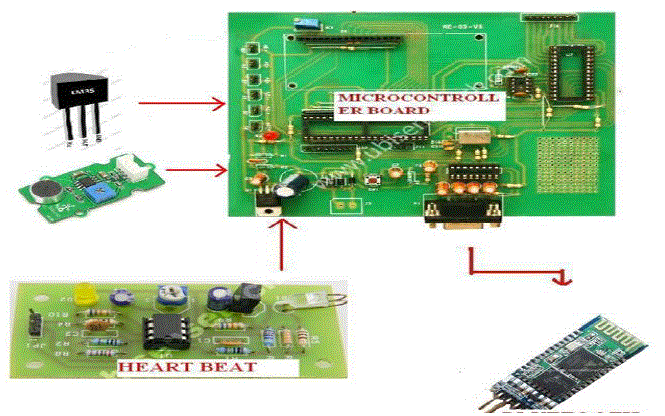 |
| 2.2 Receiver: |
| In the receiving section receiver Bluetooth module will receive the status of all sensors and transferred to smart phone from there user can know about the patient status. |
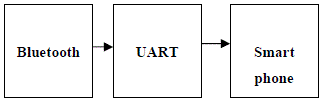 |
PROJECT DESIGN METHODOLOGY |
| Here we wi l l focu s on the principle involved in the design of the project LM35 temperature sensor, hear beat sensor, MEMS sensor and body temperature sensor are interfaced to ARM7 microcontroller along with 16X2 LCD. |
| 3.1 MEMS sensor: |
| This sensor will identify motions with respect to X, Y and Z axis which occurs in a |
| Patient’s body and generates a voltage signal as output. |
| 3.2 LM35: This sensor will identifies the changes in environment temperature and gives information in terms of voltage signal. |
| 3.3 Heart Beat sensor: A pair of LED and LDR is used to calculate the heart beat rate of a human body depending on the blood pumping and circulation motions and gives information in terms of voltage signal. |
| 3.4. ARM7 microcontroller: ARM7 LPC2148 controller is used in this project with interfacing of sensors and LCD along with Bluetooth. Controller is configured with 64 pins in QFP (Quad Flat Package) with 512k Flash memory and 32KB RAM 2 I/O ports of 32 bit wide, 2 timers/counters along with two ADC’s with total of 14 channels |
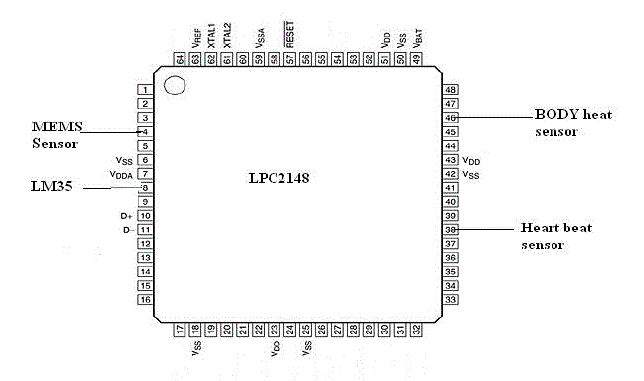 |
| 3.1 MEMS sensor: |
| MEMS are Micro Electro Mechanical System. It works on the principle of accelerometer and calculates positional changes with respect to X,Y and Z axis depending on the movements in respective directions in terms of pressure, velocity and displacement |
| They became indispensable in automobile industry, computer and audiovideo technology. This seminar presents MEMS techno logy as a highly developing industry. attention is given to the capacitor accelerometers, how do they work and their applications. |
| 3.1.1 Features: |
| ? 5 volts power supply |
| ? Chip is fabricated in 100μm technology by using purest form of Silicon wafer |
| ? Calculates vibrations changes in 3 directions |
| ? Generated output voltage is compatible with microcontroller |
| 3.2 LM35 Temperature sensor: |
| The LM35 sensor series are precision integrated-circuit temperature sensors, whose output voltage is linearly proportional to the Celsius (Centigrade) temperature. |
 |
| LM35 Sensor Specification: |
| The LM35 series are precision integrated-circuit LM35 temperature sensors, whose output voltage is linearly proportional to the Celsius (Centigrade) temperature. The LM35 sensor thus has an advantage over linear temperature sensors calibrated in Kelvin, as the user is not required to subtract a large constant voltage from its output to obtain convenient Centigrade scaling. |
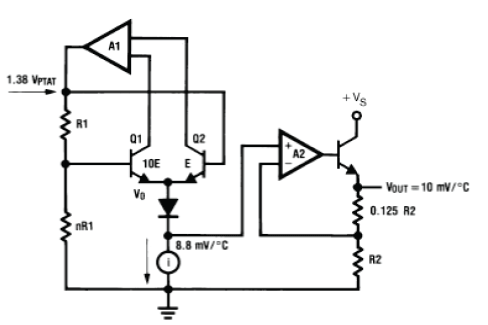 |
| Features |
| ? Calibrated directly in ° Celsius (Centigrade) |
| ? Linear + 10.0 mV/°C scale factor |
| ? 0.5°C accuracy guarantee able (at +25°C) |
| ? Rated for full −55° to +150°C range |
| ? Suitable for remote applications |
| ? Low cost due to wafer-level trimming |
| ? Operates from 4 to 30 volts |
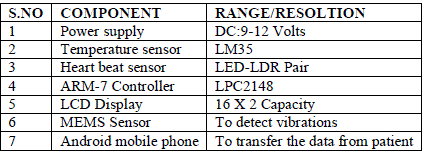 |
| 3.3 HEART BEAT SENSOR: |
| When the heart beat detector is working, the beat LED flashes in unison with each heart beat. This digital output can be connected to microcontroller directly to measure the Beats per Minute (BPM) rate. It works on the principle of light modulation by blood flow through finger at each pulse. Heart beat sensor is designed to give digital output of heat beat when a finger is placed on it. |
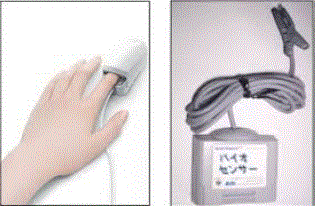 |
| Features |
| ? Microcontroller based SMD design |
| ? Heat beat indication by LED |
| ? Instant output digital signal for directly connecting to microcontroller |
| ? Compact Size |
| ? Working Voltage +5V DC |
| Applications |
| ? Digital Heart Rate monitor |
| ? Patient Monitoring System |
| Bio-Feedback control of robotics and applications |
| 3.4 ARM7 MICROCONTROLLER |
| The 32-bit ARM7TDMI microcontroller Training board is specifically designed to help students to master the required skills in the area of embedded systems. The kit is designed in such way that all the possible features of the microcontroller will be easily used by the students. The kit supports in system programming (ISP) which is done through serial port. Board has new and advance options which will give user the liberty of implementing complex logic used in the design of Embedded Systems. The development experience on the Board will posed an opportunity to excel in the field of Embedded Systems. |
| 3.5.1Board Features: |
| ? Processor: LPC2148 |
| ? ??2 Serial ports(One for ISP and other for Serial Communication) |
| ? 12MHz crystal |
| ? On board Reset Circuit with a switch. |
| ? Dual Power supply (either through USB or using external power adapter). |
| ? Power on LED supply. |
| ? Three on-board voltage regulators 1.8V, 3.3V and 5V with up to 800mA current |
| ? Graphic LDC display interfacing port. |
| ? USB Ports. |
| ? CAN controller interfacing. |
| ? MMC/SD card interfacing. |
| ? 8 Bit LED interfacing. |
| ? EEPROM Interfacing. |
| ? On board UART. |
| 3.6.2 LPC2148 CHIP FEATURES: |
| ? 32-bit ARM7TDMI microcontroller in a tiny LQFP64 package. |
| ? 32 KB of on-chip static RAM and 512 KB of on-chip flash memory. |
| ? 128-bit wide interface/accelerator enables high-speed 60 MHz operation. |
| ? In-System Programming/In-Application Programming (ISP/IAP) via on-chip boot loader software. Single flash sector or full chip erase in 400 ms and programming 256 bytes in 1 ms. |
| ? Embedded ICE RT and Embedded Trace interfaces offer real-time debugging with the on-chip Real Monitor |
| ? USB 2.0 Full-speed compliant device controller with 2 KB of endpoint RAM. |
| ? Single 10-bit DAC provides variable analog output (LPC2142/44/46/48 only). |
| ? Two 32-bit timers/external event counters (with four capture and four compare channels each), PWM unit (six outputs) and watchdog.? Low power Real-Time Clock (RTC) with independent power and 32 kHz clock input.? Multiple serial interfaces including two UARTs (16C550), two Fast I2C-bus (400 Kbit/s), |
| ? SPI and SSP with buffering and variable data length capabilities. |
KIT OUT PUT RESULTS |
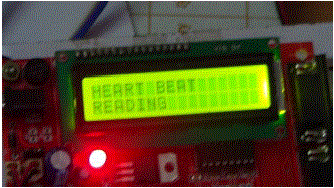 |
| (i)Kit Initialization (Project Title ) |
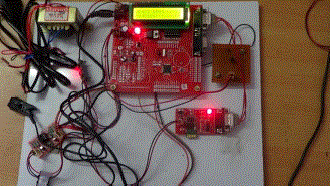 |
| (ii) Overall module interfacings |
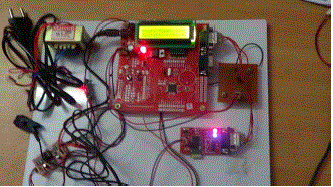 |
| (iii) Output results transmitted to mobile |
CONCLUSION & FUTURE SCOPE |
| Beside patient monitoring we had to monitor remotely not only the patient’s status, but also some mobile hardware and software specific parameters (such as: STATUS of sensors), and we had also to redesigned the whole user interface of the handheld device to support elderly persons with low IT skills. According to the received result Android based application capable to provide seamless remote monitoring of elderly persons not only at home, but with Mobile Hub also abroad. The Developed solutions provide important feedbacks about health status to the patient and to the medical experts. |